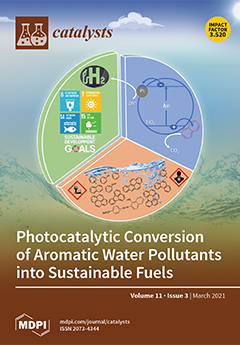One-dimensional nickel titanate nanofibers (NiTiO
3 NFs) were synthesized and loaded with acetic acid-treated exfoliated and sintered sheets of graphitic carbon nitride (AAs-gC
3N
4) to fabricate a unique heterogeneous structure. This novel fabrication method for porous AAs-gC
3N
4 sheets using acetic acid-treated exfoliation followed by sintering provided gC
3N
4 with a surface area manifold larger than that of bulk gC
3N
4, with an abundance of catalytically active sites. Hybrid photocatalysts were synthesized through a two-step process. Firstly, NiTiO
3 NFs (360 nm in diameter) were made by electrospinning, and these NiTiO
3 NFs were sensitized with exfoliated gC
3N
4 sheets via a sonication process. Varying the weight ratio of NiTiO
3 fibers to porous AAs-gC
3N
4 established that NiTiO
3 NFs containing 40 wt% of porous AAs-gC
3N
4 exhibited optimal activity, i.e., removal of methylene blue and H
2 evolution. After 60 min exposure to visible light irradiation, 97% of the methylene blue molecules were removed by the hybrid photocatalyst, compared with 82%, 72%, and 76% by pristine AAs-gC
3N
4, NiTiO
3 NFs, and bulk gC
3N
4, respectively. The optimal structure also displayed excellent H
2 evolution performance. The H
2 evolution rate in the optimal sample (152 μmol g
−1) was 2.2, 3.2 and 3-fold higher than that in pure AAs-gC
3N
4 (69 μmol g
−1), NiTiO
3 NFs (47 μmol g
−1) and bulk gC
3N
4 (50 μmol g
−1), respectively. This clearly shows that the holey AAs-gC
3N
4 nanosheets interacted synergistically with the NiTiO
3 NFs. This extended the lifetime of photogenerated charge carriers and resulted in superior photocatalytic activity compared with pristine NiTiO
3 NFs and bulk gC
3N
4. The higher Brunauer-Emmett-Teller surface area and the presence of many catalytically active sites also enhanced the photocatalytic performance of the hybrid sample. Moreover, through photoluminescence and photocurrent response analysis, a significant decrease in the recombination losses of the hybrid photocatalysts was also confirmed. Thus, this is a novel strategy to fabricate highly efficient photocatalysts with precisely tunable operating windows and enhanced charge separation.
Full article





